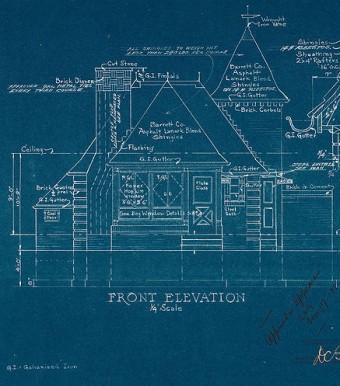Why Blueprints are Blue
 Making copies of architectural drawings hasn’t always been the easiest thing in the world to do. For the majority of human history, the most economical solution was simply to have someone make a tracing of the original plans.
Making copies of architectural drawings hasn’t always been the easiest thing in the world to do. For the majority of human history, the most economical solution was simply to have someone make a tracing of the original plans.
In the mid-nineteenth century, the process abruptly became much quicker and easier thanks to famed polymath Sir John Herschel. In 1842, Herschel invented a method to easily copy drawings using potassium ferrocyanide and ammonium iron citrate.
The exact method, called cyanotype, is performed as follows. First, you take a drawing of the plans done on relatively translucent tracing paper or cloth and place it on top of and attach it to paper (or sometimes linen, Mylar, etc.) that has been previously soaked in a mixture of the aforementioned two chemicals, then dried. Next, you expose the papers to a bright ultra-violet light source, such as the Sun, for several minutes.
The result is that the paper soaked in the chemicals ends up turning blue as the chemicals react to the light and form a compound called blue ferric ferrocyanide, also known as “Prussian Blue.”
This wouldn’t be very helpful for making a copy of a document except for the fact that where the light cannot penetrate the translucent paper, namely where the drawing marks are, the coated paper remains the original color of the paper, usually white, effectively making a nice copy.
You might see a potential problem here in that you then can’t expose the un-blued bits to any bright light source at first, but this problem is easily solved by simply washing the chemicals off, then allowing the paper to dry. At this point, the copy is complete.
Within a few decades of the discovery of this method of copying (as well as other blue-printing methods such as one developed by Alphonse Louis Poitevin in 1861 using ferro-gallate), the price dropped to about one-tenth the cost of having someone simply trace the original plans, helping the popularity of blueprints explode.
In the mid-twentieth century, copying methods such as as diazo prints, and then later xerographic prints, finally supplanted blueprints. Much more recently, simply sticking with digital versions of plans has become popular, with these having the advantage of being easy to modify and distribute as needed during the construction process.
Despite the technological changes and the fact that these plans usually aren’t on blue paper anymore, in popular vernacular the term “blueprints” has stuck around anyways.
If you liked this article, you might also enjoy our new popular podcast, The BrainFood Show (iTunes, Spotify, Google Play Music, Feed), as well as:
- Our Book: The Wise Book of Whys, whence this article came: Print / Kindle | Nook | Audiobook
- Why is Nicotine Addictive
- Why Is It Illegal to Remove Your Mattress and Pillow Tags?
- Why School Buses Are Yellow
- Why Do Asian Nations Use Chopsticks?
Bonus Fact:
- Besides contributing the cyanotype blueprinting method to the world, Sir John Herschel was also the first to apply the terms “negative” and “positive” to photography; named seven of the moons of Saturn; did a translation of The Iliad into English; greatly influenced Charles Darwin’s work, with Darwin calling Herschel “one of our greatest philosophers” in On the Origin of Species; among many, many other contributions to various fields, particularly astronomy, as well as the emerging field of photography.
| Share the Knowledge! |
|





VERY DECENT ETYMOLOGICAL PIECE, TNX
Something to note about diazo printing, it uses ammonium hydroxide to create the blue lines on the page. As it gets used up, it becomes water. If you’re checking to see if there’s still enough of an ammonium hydroxide concentration left in the bottle, don’t put your nose right up to it. Because smelling ammonium hydroxide feels like getting punched in the face.
@James L.: Interesting stuff. Thanks!
You mention: In 1842, Herschel invented a method to easily copy drawings using potassium ferrocyanide and ammonium iron citrate.
Thanks for the article. Nicely done.
I have also found this in another article on the same subject: In 1861 Alphonse Louis Poitevin, a French chemist, found that ferro-gallate in gum is light sensitive. Light turns this to an insoluble permanent blue. A coating of this chemical on a paper or other base may be used to reproduce an image from a translucent document.
In the novel I’m writing, the printers are using ferro-gallate as the medium. Any idea what ferro-gallate smells like?
I never took into account the fact that blueprints made it a lot easier for people to copy prints. That is such a fascinating fact about this planning method I had not heard before. This might be a fun fact to bring up to my brother as he searches for a drafting service.